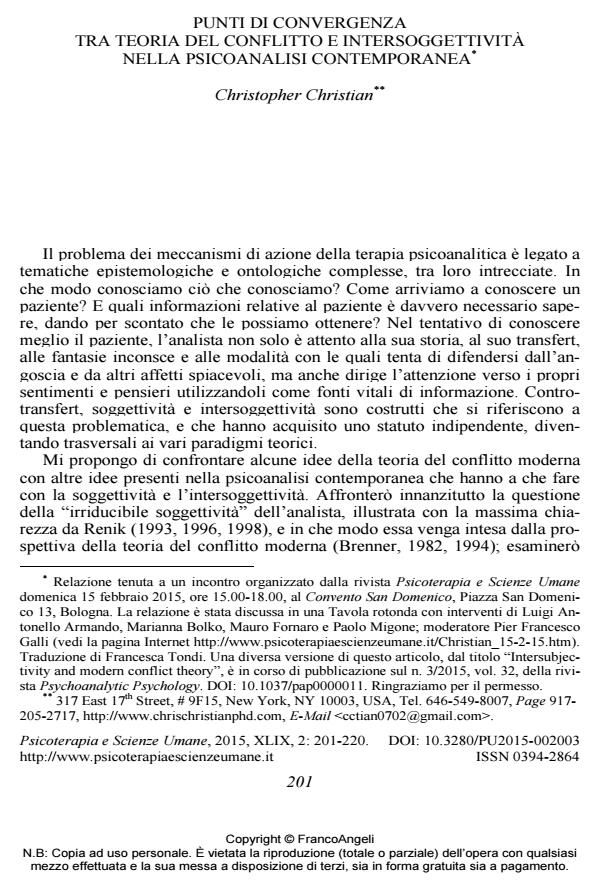Convergences between modern conflict theory and intersubjectivity in contemporary psychoanalysis
Journal title PSICOTERAPIA E SCIENZE UMANE
Author/s Christopher Christian
Publishing Year 2015 Issue 2015/2
Language Italian Pages 20 P. 201-220 File size 92 KB
DOI 10.3280/PU2015-002003
DOI is like a bar code for intellectual property: to have more infomation
click here
Below, you can see the article first page
If you want to buy this article in PDF format, you can do it, following the instructions to buy download credits

FrancoAngeli is member of Publishers International Linking Association, Inc (PILA), a not-for-profit association which run the CrossRef service enabling links to and from online scholarly content.
Subjectivity and intersubjectivity, like countertransference, are terms that have come into their own, cutting across theoretical paradigms in psychoanalysis. Intersubjectivity is explored from the perspective of modern conflict theory, and it is argued that there is much in common between Charles Brenner and Jacob Arlow’s ideas about how the analyst’s mind works, on the one hand, and intersubjective and relational psychoanalysis, on the other. Where the concept of intersubjectivity becomes contentious is when we draw implications regarding the claims the analyst can make about ever knowing the analysand’s mind as a separate entity from his or her own.
Keywords: Intersubjective psychoanalysis, modern conflict theory in psychoanalysis, Charles Brenner, relational psychoanalysis, countertransference
- Ruoli affettivi, compiti e decisioni Alfio Maggiolini, in PSICOTERAPIA E SCIENZE UMANE 1/2017 pp.75
DOI: 10.3280/PU2017-001005 - Ascoltando, appuntando. Viaggio tra Freud e Ferenczi Silvana Valle, in PSICOTERAPIA PSICOANALITICA 1/2018 pp.35
DOI: 10.3280/PSP2018-001004 - Sul prendere appunti durante la seduta Paolo Migone, in PSICOTERAPIA PSICOANALITICA 1/2018 pp.24
DOI: 10.3280/PSP2018-001003 - Alcune pubblicazioni di Pier Francesco Galli elencate in ordine cronologico A cura della Redazione, in PSICOTERAPIA E SCIENZE UMANE 3/2024 pp.419
DOI: 10.3280/PU2024-003003
Christopher Christian, Punti di convergenza tra teoria del conflitto e intersoggettività nella psicoanalisi contemporanea in "PSICOTERAPIA E SCIENZE UMANE" 2/2015, pp 201-220, DOI: 10.3280/PU2015-002003